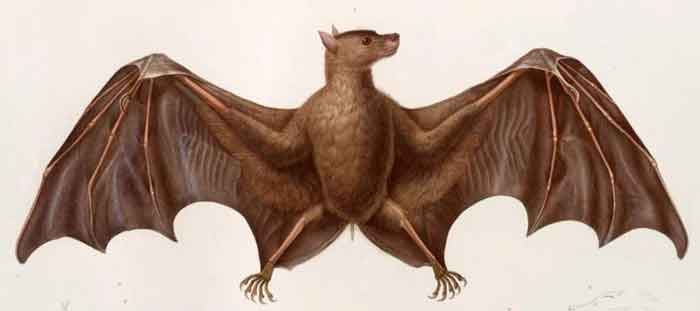
Superregnum: Eukaryota
Cladus: Unikonta
Cladus: Opisthokonta
Cladus: Holozoa
Regnum: Animalia
Subregnum: Eumetazoa
Cladus: Bilateria
Cladus: Nephrozoa
Superphylum: Deuterostomia
Phylum: Chordata
Subphylum: Vertebrata
Infraphylum: Gnathostomata
Megaclassis: Osteichthyes
Cladus: Sarcopterygii
Cladus: Rhipidistia
Cladus: Tetrapodomorpha
Cladus: Eotetrapodiformes
Cladus: Elpistostegalia
Superclassis: Tetrapoda
Cladus: Reptiliomorpha
Cladus: Amniota
Cladus: Synapsida
Cladus: Eupelycosauria
Cladus: Sphenacodontia
Cladus: Sphenacodontoidea
Cladus: Therapsida
Cladus: Theriodontia
Cladus: Cynodontia
Cladus: Eucynodontia
Cladus: Probainognathia
Cladus: Prozostrodontia
Cladus: Mammaliaformes
Classis: Mammalia
Subclassis: Trechnotheria
Infraclassis: Zatheria
Supercohors: Theria
Cohors: Eutheria
Infraclassis: Placentalia
Cladus: Boreoeutheria
Superordo: Laurasiatheria
Cladus: Scrotifera
Ordo: Chiroptera
Subordo: Yinpterochiroptera
Familia: Pteropodidae
Subfamilia: Harpyionycterinae
Subtribus: Dobsoniini
Genus: Dobsonia
Species: Dobsonia moluccensis
Name
Dobsonia moluccensis Quoy & Gaimard, 1830
Type locality: Indonesia, Maluku (Moluccas), Amboina Island.
References
Quoy & Gaimard. 1830. In d'Urville, Voy. de Astrolabe, Zool., 1(L'Homme, Mamm. Oiseaux): 86.
Distribution
Molucca Islands including Bacan, Buru and Seram
Banda Islands, Aru Islands, Waigeo (Province of Papua, Indonesia)
Vernacular names
English: Moluccan Naked-backed Fruit Bat
The bare-backed fruit bat or Moluccan naked-backed fruit bat (Dobsonia moluccensis) is a fruit bat in the family Pteropodidae.
Taxonomy and etymology
It was described as a new species in 1830 by Jean René Constant Quoy and Joseph Paul Gaimard who placed it in the now-defunct bat genus Hypoderma, with the scientific name H. moluccensis.[2] Its relationship with Dobsonia magna requires further investigation.[1] Its species name "moluccensis" means "belonging to the Moluccas," which is where the species is found.
Description
Its fur is brown and its feet have distinctive white claws. It is smaller than the New Guinea naked-backed fruit bat.[3] Males weigh 380–500 g (0.84–1.10 lb) while females weigh 325–525 g (0.717–1.157 lb). Its ears are pointed, and its second digits lack claws, unlike flying foxes. Its wings attach at the back along the spine rather than along the sides of the body.[4]
Biology and ecology
The bare-backed fruit bat is a seasonal breeder, with the mating season from April to June. Females give birth from mid-August through November.[4] It is found in Indonesia, East Timor, Papua New Guinea, and Australia. It has been documented from 0–2,700 m (0–8,858 ft) above sea level.[1]
As of 2016, it is considered a least-concern species by the IUCN.[1]
References
Tsang, S.M. (2016). "Dobsonia moluccensis". IUCN Red List of Threatened Species. 2016: e.T84882605A22033630. doi:10.2305/IUCN.UK.2016-3.RLTS.T84882605A22033630.en. Retrieved 19 November 2021.
Quoy, J.R.; Gaimard, J.P. (1830). Voyage de la corvette l'Astrolabe : exécuté par ordre du roi, pendant les années 1826-1827-1828-1829. Vol. 1. Paris :J. Tastu, 1830-1834. pp. 86–88.
Flannery, T. (1995). Mammals of the South-West Pacific & Moluccan Islands. Cornell University Press. p. 202. ISBN 978-0801431500.
Nowak, R. M. (1994). Walker's Bats of the World. JHU Press. pp. 61–62. ISBN 978-0801849862.
Retrieved from "http://en.wikipedia.org/"
All text is available under the terms of the GNU Free Documentation License

